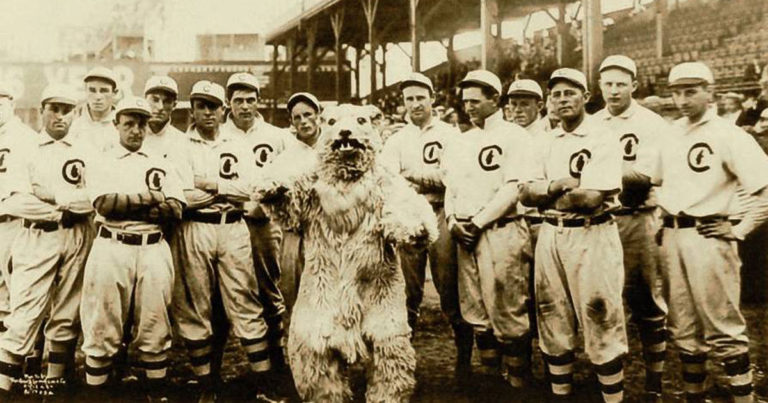Last time the Chicago Cubs won the World Series, the BSA didn’t yet exist

Mordecai Brown, Frank Chance, Johnny Evers and the rest of the World Series champion Chicago Cubs were never Boy Scouts.
How do we know? Because in 1908, the year they won the World Series, the Boy Scouts of America didn’t yet exist.
The future Hall of Famers were 31, 32 and 27, respectively, the last time the Cubs won baseball’s top prize: Oct. 14, 1908.
The BSA was founded Feb. 8, 1910 — exactly 482 days later.
A lot has changed in the 106 years since the BSA’s founding (and 108 since the Cubs’ last title).
More than 100 million youth members have experienced Scouting’s transformative power — in Boy Scouting, Cub Scouting, Venturing, Varsity Scouting, Exploring and Sea Scouting.
Scouting continues to be the nation’s top youth program of character development and values-based leadership training in 2016 and beyond. But today, let’s step back to a time before Scouting — or at least American Scouting — existed.
Scouting in 1907
Though the Boy Scouts of America hadn’t yet begun when the Cubs won the 1908 World Series, the worldwide Scouting movement already was blossoming.
In the summer of 1907 on Brownsea Island off England’s southern coast, Robert Baden-Powell set up the first Scout camp. There he tested his ideas for training boys.
Scouting magazine, in its September 1999 issue, picks up the story from there:
He planned a full program of activities, including campfire stories to teach such abstract concepts as honor and loyalty, and games and contests on such practical skills as tracking, signaling, pioneering, and first aid.
Scouting’s patrol system was established at Brownsea. In the army, B-P had found the best way to train scouts was in small groups. So the Brownsea campers were divided into four patrols, with the oldest boy as patrol leader.
For patrol identification, the boys were given long, wool streamers in different colors to pin on their left shoulder — green for Bulls, blue for Wolves, yellow for Curlews, and red for Ravens.
Scouting in 1908
On Jan. 24, 1908, Baden-Powell published Scouting for Boys, a pocketable book that promised outdoor fun and outlined the many ways boys could serve their country through Scouting.
For more, here’s this from Scouting magazine’s March-April 2004 issue:
Scouting for Boys introduced the Scout Promise (Oath), Scout Law, motto, badge, Scout sign and salute, and the handshake. It told how to form a patrol and how to earn advancement.
More important, readers learned how to hike and camp, tie knots and do pioneering projects, track and stalk animals, find directions, and signal with Morse code and flags.
Baden-Powell biographer Tim Jeal points out, “For thousands of boys who had never slept away from home, and for many more who had never left their hometowns even for a day, this idea of going off with friends on an ambitious expedition was intoxicating.”
Tens of thousands of copies of Scouting for Boys were snapped up in the first year (Jeal reports that the precise number is unknown) and Scout troops began organizing all over the British Isles. Within weeks, copies were appearing in America and many other countries.
A worldwide movement was underway.
By the end of 1908, some 60,000 Boy Scouts has signed on to the movement.
 Scouting in 1909 and 1910
Scouting in 1909 and 1910
In 1909, Chicago publisher William D. Boyce got lost in the London fog when a Boy Scout came to his aid.
Instead of accepting payment for his Good Turn, the “Unknown Scout” simply said that he’s a Boy Scout, and good deeds are what Boy Scouts do.
That led Boyce to collect a trunkload of literature about the Scouting movement. He read it and was impressed.
The next year, on Feb. 8, 1910, Boyce and others incorporated the Boy Scouts of America.
 Boyce’s Chicago Cubs connection
Boyce’s Chicago Cubs connection
I mentioned Boyce was a Chicago-based publisher. While many in the city knew him as a newspaper man — he owned the Chicago Ledger and Saturday Blade — he also published books.
In 1912, Boyce asked pitcher Mordecai Brown — who was missing parts of two fingers on his pitching hand — to write a series of books for boys about pitching technique.
The series, How to Pitch Curves, included tips on physical pitching skills like the “out-drop,” “in-curve” and spitball. But it also taught the mental game — skills like positive attitude and grit that young men and young women also acquire in Scouting.
According to the book Three Finger: The Mordecai Brown Story, the Boyce Company sold 1.2 million copies of Brown’s books every week in 1913.
Last time the Chicago Cubs won the World Series, the BSA didn’t yet exist
